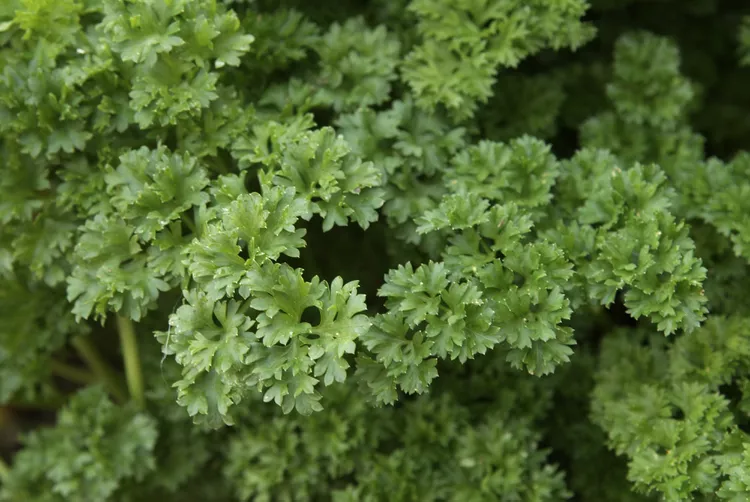Parsley is an easy-to-grow herb that can be cultivated in outdoor herb gardens or on a sunny kitchen windowsill. If you this herb in your garden last year, perhaps you're now wondering, "Is parsley a perennial?" Or does it need to be replanted every spring? Find the answers to these questions below so you'll be able to get the most out of your parsley plants.
Is Parsley a Perennial or Annual?
So, is parsley a perennial or annual plant? The answer is neither. Although gardeners often grow parsley as an annual, starting with new plants each year, it is technically a biennial plant, meaning it takes two years to complete its entire life cycle.
Most often, parsley seeds are planted in spring, and the plants die back in fall when cold temperatures arrive. However, if you don’t pull up parsley in autumn, the roots will survive the winter in most areas and regrow again the following spring. In the second year of growth, parsley will flower and make seeds before completely dying and not returning the next spring.
First-Year Parsley vs. Second-Year Parsley
While first- and second-year parsley are both edible, parsley plants behave differently as they age. Understanding the key differences between first- and second-year parsley can help you get the most out of your parsley crop and set your herb garden up for success.
Growing First-Year Parsley
During the first year, parsley seeds sprout and produce a lush crop of edible stems and leaves about 70 to 100 days after planting. First-year parsley is typically harvested little by little from summer through fall by snipping parsley stems off at the soil line. This gradual harvest rejuvenates the plant’s growth and provides just the right amount of fresh parsley for cooking. Later in the season, parsley plants can be harvested more aggressively since the plant’s leaves will all die back when a hard frost arrives.
After harvesting parsley in autumn, many gardeners pull up their first-year parsley plants and compost them, but parsley roots survive winters in USDA Hardiness Zones 3 and warmer and regrow in spring if you let them. In most areas, parsley doesn’t need extra protection in winter—just cut the plants down to a few inches above the soil line and add a little mulch.
Growing Second-Year Parsley
Second-year parsley plants emerge early in spring, just in time to flavor garden salads and other springtime recipes. While fresh parsley leaves are always a treat, most gardeners keep second-year parsley plants around for another reason; parsley only flowers and produces seeds during its second year.
Clusters of white flowers emerge toward the end of spring and into early summer, and those petite blooms are highly attractive to beneficial insects and pollinators of all sorts. Although the flavor of parsley leaves degrades after the plant blooms, flowering parsley makes a fantastic companion plant for natural pest control and is a good choice for pollinator habitats.
As the season progresses, parsley flowers eventually die back, leaving behind lots of seeds. Those seeds can be allowed to self-sow right in garden beds, or you can gather and save them to plant the following spring.
Succession Planting Parsley
Like many other herbs, parsley seeds can be planted in succession every few weeks throughout the growing season for a more prolific crop. You can also succession plant parsley every spring for a nearly continuous crop of parsley.
Overwintering biennial parsley plants is the best way to get fresh parsley leaves early in spring, and it works particularly well with succession planting. Overseed second-year parsley in spring with fresh parsley seeds and wait for the new parsley seeds to sprout. By the time the older, second-year parsley plants begin to bolt, the newly planted first-year parsley is ready for harvesting.
How to Grow Parsley Year-Round
Parsley is a surprisingly cold-hardy herb, and it can continue to grow outdoors all winter long in areas with mild climates. In colder areas, parsley leaves usually die back when a hard frost hits. However, cold-weather gardeners can continue to grow parsley through the winter by keeping indoor parsley plants.
Outdoor parsley plants usually don’t transplant well, so starting your indoor herb garden with new parsley seeds is best.
You can sow indoor parsley seeds at any time of the year, but if you want your plants to be a harvestable size in winter, plant parsley seeds indoors at the end of summer or in early fall.
To grow parsley in pots:
- Select a growing container that is at least 10 inches in diameter and has drainage holes.
- Fill the container with potting mix and lightly scatter parsley seeds over the soil.
- Cover the seeds with ½ inch of soil, water them well, and move them to a sunny location that receives at least eight hours of light daily.
- When the parsley seedlings have two sets of true leaves, thin out the seedlings, leaving about an inch between each sprout.
If you don’t have a brightly lit window, a grow light is a must because indoor parsley requires lots of light.
During the winter, your indoor parsley garden should fill in beautifully and provide your kitchen with the perfect amount of parsley for your favorite recipes. Once spring arrives, harden off your potted parsley plants and move them outdoors, or plant them in your herb garden.




















